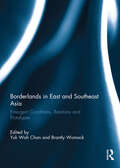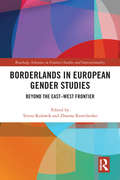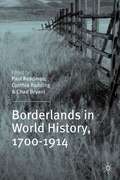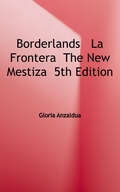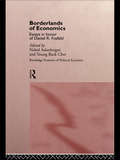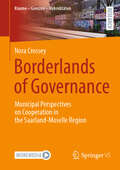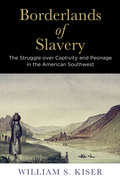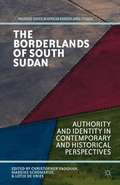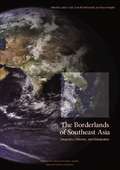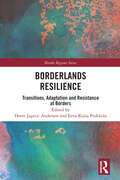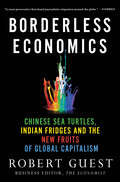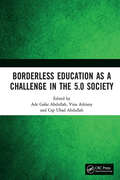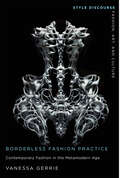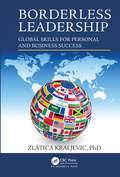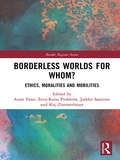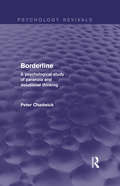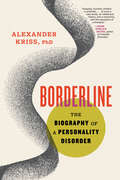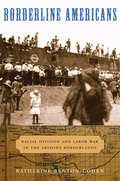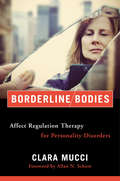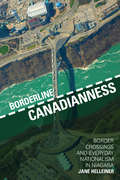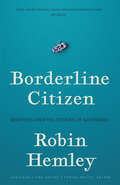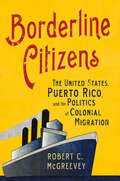- Table View
- List View
Borderlands in East and Southeast Asia: Emergent conditions, relations and prototypes
by Yuk Wah Chan and Brantly WomackThis book provides a glimpse into the different emergent borderland prototypes in East and Southeast Asia, with illustrative cases and discussions. Asia has contained a number of reactivated border zones since the end of the Cold War, borders which have witnessed ever greater human activity, concerning trade, commerce, tourism, and other forms of money-related activities such as shopping, gambling and job-seeking. Through seven borderland cases, the contributors to this volume analyse how the changing political economy and the regional and international politics of Asia have shaped and reshaped borderland relations and produced a few essential prototypes of borderland in Asia, such as reopened borders and re-activated economic zones; reintegrated but "separated" border cities; porous borderlands; and abstruse borderlands. This book aims to bring about further discussions of borderland development and governance, and how these actually inform and shape state-state and state-city relations across borders and regional politics. This book was originally published as a special issue of Asian Anthropology.
Borderlands in European Gender Studies: Beyond the East–West Frontier (Routledge Advances in Feminist Studies and Intersectionality)
by Teresa Kulawik Zhanna KravchenkoChallenging persistent geopolitical asymmetries in feminist knowledge production, this collection depicts collisions between concepts and lived experiences, between academic feminism and political activism, between the West as generalizable and the East as the concrete Other. Borderlands in European Gender Studies narrows the gap between cultural analysis and social theory, addressing feminist theory’s epistemological foundations and its capacity to confront the legacies of colonialism and socialism. The contributions demonstrate the enduring worth of feminist concepts for critical analysis, conceptualize resistance to multiple forms of oppression, and identify the implications of the decoupling of cultural and social feminist critique for the analysis of gender relations in a postsocialist space. This book will be of import to activists and researchers in women’s and gender studies, comparative gender politics and policy, political science, sociology, contemporary history, and European studies. It is suitable for use as a supplemental text for advanced undergraduate and graduate courses in a range of fields.
Borderlands in World History, 1700-1914
by Paul Readman Cynthia Radding Chad BryantCovering two hundred years, this groundbreaking book brings together essays on borderlands by leading experts in the modern history of the Americas, Europe, Africa, Asia and Australia to offer the first historical study of borderlands with a global reach.
Borderlands / La Frontera: The New Mestiza
by Gloria AnzaldúaA new edition of Anzaldúa's classic text. "The U.S-Mexican border es una herida abierta where the Third World grates against the first and bleeds. And before a scab forms it hemorrhages again, the lifeblood of two worlds merging to form a third country—a border culture." <p>Gloria Anzaldúa <p><p>Rooted in Gloria Anzaldúa's experience as a Chicana, a lesbian, an activist, and a writer, the essays and poems in BORDERLANDS/LA FRONTERA: THE NEW MESTIZA profoundly challenged, and continue to challenge, how we think about identity. BORDERLANDS/LA FRONTERA remaps our understanding of what a "border' is, presenting it not as a simple divide between here and there, us and them, but as a psychic, social, and cultural terrain that we inhabit, and that inhabits all of us.
Borderlands of Blindness (Disability in Society Series)
by Beth OmanskyBeth Omansky explores the lives of people with legal blindness to show how society responds to those who don't fit neatly into the disabled/nondisabled binary. Probing the experience of education, rehabilitation, and work, as well as the more intimate spheres of religion, family, and romantic relationships, her frank and theoretically sophisticated portrait of the legally blind experience offers an insight into our understanding of the social construction of disability.
Borderlands of Economics: Essays in Honour of Daniel R. Fusfeld (Routledge Frontiers of Political Economy #Vol. 11)
by Nahid Aslanbeigui Young Back ChoiIn recent years there has been increasing discontent with the abstract nature of mainstream economics. Not only does this make the subject less relevant to real issues, it drives a wedge between economics and other disciplines ostensibly addressing the same issues. Borderlands of Economics explores the ways in which economics might be reconnected, both with the real world and with other disciplines.
Borderlands of Governance: Municipal Perspectives on Cooperation in the Saarland-Moselle Region (Räume – Grenzen – Hybriditäten)
by Nora CrosseyRecognizing European cross-border cooperation as a complex multilevel governance shaped by both bottom-up and top-down processes, and viewing recent border-regional strategies as a catalyst for decentralizing cross-border relations in French-German border regions, this book examines municipal actors&’ perspectives in the &“Greater Region&”, specifically the département Moselle and the German Saarland. Bridging governance and border studies by adopting a lens of &“borderlands of governance&”, it studies the contributions of intermunicipal cross-border governance to processes of bordering and &“place-making&” and to systems of multilevel cross-border governance. (In)formal intermunicipal cross-border networks – whose relevance and ingenuity became particularly evident during the Covid-19 pandemic – play a crucial role for the functioning of the borderspaces, in some instances evolving into &“quasi-territorial&” governance reflecting communities beyond national borders yet remaining bound to logics of territoriality and sovereignty. Here, the conceptualisation of &“borderlands of governance&” offers a framework for understanding them as contingent elements of multilevel cross-border governance.
Borderlands of Slavery: The Struggle over Captivity and Peonage in the American Southwest (America in the Nineteenth Century)
by William S. KiserIt is often taken as a simple truth that the Civil War and the Thirteenth Amendment to the Constitution ended slavery in the United States. In the Southwest, however, two coercive labor systems, debt peonage—in which a debtor negotiated a relationship of servitude, often lifelong, to a creditor—and Indian captivity, not only outlived the Civil War but prompted a new struggle to define freedom and bondage in the United States.In Borderlands of Slavery, William S. Kiser presents a comprehensive history of debt peonage and Indian captivity in the territory of New Mexico after the Civil War. It begins in the early 1700s with the development of Indian slavery through slave raiding and fictive kinship. By the early 1800s, debt peonage had emerged as a secondary form of coerced servitude in the Southwest, augmenting Indian slavery to meet increasing demand for labor. While indigenous captivity has received considerable scholarly attention, the widespread practice of debt peonage has been largely ignored. Kiser makes the case that these two intertwined systems were of not just regional but also national importance and must be understood within the context of antebellum slavery, the Civil War, emancipation, and Reconstruction.Kiser argues that the struggle over Indian captivity and debt peonage in the Southwest helped both to broaden the public understanding of forced servitude in post-Civil War America and to expand political and judicial philosophy regarding free labor in the reunified republic. Borderlands of Slavery emphasizes the lasting legacies of captivity and peonage in Southwestern culture and society as well as in the coercive African American labor regimes in the Jim Crow South that persevered into the early twentieth century.
The Borderlands of South Sudan
by Christopher Vaughan Mareike Schomerus Lotje De VriesMoving beyond the current fixation on "state construction," the interdisciplinary work gathered here explores regulatory authority in South Sudan's borderlands from both contemporary and historical perspectives. Taken together, these studies show how emerging governance practices challenge the bounded categorizations of "state" and "non-state. "
The Borderlands of Southeast Asia: Geopolitics, Terrorism and Globalization
by James Clad Bruce Vaughn Sean M McDonaldAs an academic field in its own right, the topic of border studies is experiencing a revival in university geography courses as well as in wider political commentary. Until recently, border studies in contemporary Southeast Asia appeared as an afterthought at best to the politics of interstate rivalry and national consolidation. The maps set out all agreed postcolonial lines. Meanwhile, the physical demarcation of these boundaries lagged. Large slices of territory, on land and at sea, eluded definition or delineation.That comforting ambiguity has disappeared. Both evolving technologies and price levels enable rapid resource extraction in places, and in volumes, once scarcely imaginable. The beginning of the 21st century's second decade is witnessing an intensifying diplomacy, both state-to-state and commercial, over offshore petroleum. In particular, the South China Sea has moved from being a rather arcane area of conflict studies to the status of a bellwether issue. Along with other contested areas in the western Pacific and south Asia, the problem increasingly defines China's regional relationships in Asia—and with powers outside the region, especially the United States. Yet intraregional territorial differences also hobble multilateral diplomacy to counter Chinese claims, and daily management of borders remains burdened by a lot of retrospective baggage.The contributors to this book emphasize this mix of heritage and history as the primary leitmotif for contemporary border rivalries and dynamics. Whether the region's 11 states want it or not, their bordered identity is falling into ever sharper definition—if only because of pressure from extraregional states. Chapters are organized by country to elicit a broad range of thought and approach as much as for the specific areas or nation-states examined in each chapter. This book aims to provide new ways of looking at the reality and illusion of bordered Southeast Asia.
Borderlands Resilience: Transitions, Adaptation and Resistance at Borders (Border Regions Series)
by Dorte Jagetic Andersen Eeva-Kaisa ProkkolaThis book offers new insights into the current, highly complex border transitions taking place at the EU internal and external border areas, as well as globally. It focuses on new frontiers and intersections between borders, borderlands and resilience, developing new understandings of resilience through the prism of borders. The book provides new perspectives into how different groups of people and communities experience, adapt and resist the transitions and uncertainties of border closures and securitization in their everyday and professional lives. The book also provides new methodological guidelines for the study of borders and multi-sited bordering and resilience processes. The book bridges border studies and social scientific resilience research in new and innovative. It will be of interest to students and scholars in geography, political studies, international relations, security studies and anthropology.
Borderless Economics: Chinese Sea Turtles, Indian Fridges and the New Fruits of Global Capitalism
by Robert GuestAn editor for The Economist looks at how international diasporas are accelerating and diversifying the flow of ideas, technology, and wealth, improving lives across the globe.A century ago, migrants often crossed an ocean and never saw their homelands again. Today, they call—or Skype—home the moment their flight has landed, and that's just the beginning. Thanks to cheap travel and easy communication, immigrants everywhere stay in intimate contact with their native countries, creating powerful cross-border networks. In Borderless Economics, Robert Guest travels through dozens of countries and 44 American states, observing how these networks create wealth, spread ideas, and foster innovation.Covering phenomena such as how young Chinese studying in the West are infecting China with democratic ideals, to why the so-called "brain drain"—the flow of educated migrants from poor countries to rich ones—actually reduces global poverty, this is a fascinating look at how migration makes the world wealthier and happier.
Borderless Education as a Challenge in the 5.0 Society: Proceedings of the 3rd International Conference on Educational Sciences (ICES 2019), November 7, 2019, Bandung, Indonesia
by Ade Gafar AbdullahThese proceedings contain a selection of papers presented at the 3rd International Conference on Educational Sciences, organized on 16 November 2019. It covers themes such as philosophy and policy of teacher education; curriculum, teaching and learning approaches; learner’s characteristics in the digital era; global citizenship education; vocational education; teacher education qualification framework; management, supervision and assessment; lifelong learning for all; diversity in education; equality of educational opportunity; vocational and entrepreneurship education; and education in the industry 4.0 era.
Borderless Fashion Practice: Contemporary Fashion in the Metamodern Age
by Vanessa GerrieTwenty-first century fashion practice has become increasingly borderless and diverse in the digital era, calling into question the very boundaries that define fashion in the Western cultural context. Borderless Fashion Practice: Contemporary Fashion in the Metamodern Age principally engages the work of four fashion designers -- Virgil Abloh, Aitor Throup, Iris Van Herpen, and Eckhaus Latta -- whose work intersects with other creative disciplines such as art, technology, science, architecture, and graphic design. They do their work in what Vanessa Gerrie calls the metamodern age -- the time and place where the polarization between the modern and the postmodern collapses. Used as a framework to understand the current Western cultural zeitgeist, Gerrie's exploration of the work of contemporary practitioners and theorists finds blurred borders and seeks to blur them further, to the point of erasure.
Borderless Leadership: Global Skills for Personal and Business Success
by Zlatica Kraljevic"Borderless Leadership is a must read for anyone involved in international business. It enables beginners to avoid common pitfalls, and seasoned executives will recognize many of their own mistakes and benefit from the frameworks Dr. Kraljevic provides." — Professor Sibrandes Poppema, President, University of Groningen, Netherlands "I just cannot stop recommending this book to ever so many people—my academic colleagues, industry colleagues, friends in the government, former students, students, young CEOs of start-ups that I mentor, and my media friends. The book is very special, deep with several gems of ideas, told in absorbing narrative; neither a text book nor a cook book but a candid, sincere, and extremely effective set of real world lessons for so many global citizens. Dr. Kraljevic uses personal examples from across continents, in diverse industry settings. All I can say is this: Go, grab the book on a Thursday night, and you will have a wonderful weekend reading this amazing book." — Professor S. Sadagopan, Director, International Institute of Information Technology of Bangalore, India "Everything I know about international markets, I owe it to Zlática." — Sue Payne, Former ExxonMobil Area Manager U.S. & Mexico "As the global village rapidly expands, understanding borderless leadership becomes a prerequisite for international success in this 21st century. Kraljevic brings her vast and unique worldly experiences to open your mind with practical treasures, thoughtful how-to models, and conceptual insights. Find out about the human fractal on your journey to becoming a borderless leader." — Lane Sloan, Former President, Shell Chemical Company, USA Studies consistently show that international partnerships between organizations fail to generate expected results at a significant cost. The leading cause behind this failure is lack of trust among people at all levels within organizations. Borderless Leadership explores the disparity that exists between the ways that the West and other cultures conduct business. The book’s premise is that if one cannot control the events or circumstances, one must learn how to control reactions to new environments. Using real-life examples, the book illustrates how to build trust and rapport with business partners across borders and establish relationships that help businesses grow. The book is about achieving success with and through total strangers as you progress from awareness to understanding and from understanding to acquiring, internalizing, and applying new knowledge so you bring your approach to life up to date. Only then can you transform obstacles into unsuspected opportunities that will have a positive impact on your personal and business success.
Borderless Wars
by Antonia ChayesIn 2011, Nasser Al-Awlaki, a terrorist on the US 'kill list' in Yemen, was targeted by the CIA. A week later, a military strike killed his son. The following year, the US Ambassador to Pakistan resigned, undermined by CIA-conducted drone strikes of which he had no knowledge or control. The demands of the new, borderless 'gray area' conflict have cast civilians and military into unaccustomed roles with inadequate legal underpinning. As the Department of Homeland Security defends against cyber threats and civilian contractors work in paramilitary roles abroad, the legal boundaries of war demand to be outlined. In this book, former Under Secretary of the Air Force Antonia Chayes examines these new 'gray areas' in counterinsurgency, counter-terrorism and cyber warfare. Her innovative solutions for role definition and transparency will establish new guidelines in a rapidly evolving military-legal environment.
Borderless Worlds for Whom?: Ethics, Moralities and Mobilities (Border Regions Series)
by Anssi Paasi Eeva-Kaisa Prokkola Jarkko Saarinen Kaj ZimmerbauerThe optimism heralded by the end of the Cold War and the idea of an emerging borderless world was soon shadowed by conflicts, wars, terrorism, and new border walls. Migrants, asylum seekers, and refugees have simultaneously become key political figures. Border and mobility studies are now two sides of the same coin. The chapters of this volume reflect the changing relations between borders, bordering practices, and mobilities. They provide both theoretical insights and contextual knowledge on how borders, bordering practices, and ethical issues come together in mobilities. The chapters scrutinize how bounded (territorial) and open/networked (relational) spaces manifest in various contexts. The first section, ‘Borders in a borderless world’, raises theoretical questions. The second, ‘Politics of inclusion and exclusion’, looks at bordering practices in the context of migration. The third section, ‘Contested mobilities and encounters’, focuses on tourism, which has been an ‘accepted’ form of mobility but which has recently become an object of critique because of overtourism. Section four, ‘Borders, security, politics’, examines bordering practices and security in the EU and beyond, highlighting how the migration/border politics nexus has become a national and supra-national political challenge. The chapters of this interdisciplinary volume contribute both conceptually and empirically to understanding contemporary bordering practices and mobilities. It is essential reading for geographers, political scientists, sociologists, and international relations scholars interested in the contemporary meanings of borders and mobilities.
Borderline: A Psychological Study of Paranoia and Delusional Thinking (Psychology Revivals)
by Peter ChadwickOriginally published in 1992, Borderline presents a unique study of the disturbed mind. Professional psychologist Peter Chadwick draws upon his own personal experience of madness to provide a valuable exploration of the psychology of paranoia and schizophrenia. The book goes beyond a narrowly focused analytical approach to examine schizophrenia from as many perspectives as possible. Using participant observation, introspection, case study and experimental methods, Chadwick shows how paranoid and delusional thinking are only exaggerations of processes to be found in normal cognition. Impressed by the similarities between the thinking of mystics and psychotics, he argues that some forms of madness are closely related to profound mystical experience and intuition, but that these are expressed in a distorted form in the psychotic mind. He explores the many positive characteristics and capabilities of paranoid patients, providing a sympathetic account which balances the heavily negative constructions usually put on paranoia in the research literature. Borderline provides many novel insights into madness and raises important questions as to how psychosis and psychotics are to be evaluated. It will be essential reading for all practising professionals and students in clinical psychology and psychiatry, and for everyone involved in the treatment, understanding and management of schizophrenia.
Borderline: The Biography of a Personality Disorder
by Alexander KrissAn intimate, compassionate, and expansive portrait of Borderline Personality Disorder that rejects the conventional wisdom that this condition is untreatable, told by a psychologist who specializes in BPDMental illness is heavily stigmatized within our society, and within this already marginalized group, folks with BPD are deemed especially untreatable and hopeless. When, as a graduate student, Alex Kriss first began working as a therapist in the field, his supervisors warned him that borderline patients were manipulative, difficult, and had a tendancy to drop out of treatment. Yet, years later, when Kriss was establishing his private practice and a borderline patient known as Ana came to his office, he felt compelled to try to help her, despite all of the warnings he&’d heard.Borderline is the story of his work with Ana—how his successes with her led him to open his doors to other BPD patients and advocate for them. Borderline is also the story of the disorder itself: Kriss traces accounts of the condition going back to antiquity, showing how this disease has been known by many names over the millennia, most of them gendered: possession, hysteria, witchcraft, moral insanity. All referred to a person—usually a woman—whose behavior and personality were seen as fractured, unstable, unpredictable, and uncontrollable. Kriss guides us through this history up through the emergence of psychotherapy, the development of the modern diagnosis, and attitudes toward treatment today.
Borderline: Defending the Home Front
by Vincent VargasAn inside look at the U.S.-Mexico border through the eyes of former U.S. Border Patrol agent, Vincent Vargas, who served in Iraq and Afghanistan with the U.S. Army’s 75th Ranger Regiment.Featuring a Foreword by #1 New York Times bestselling author Jocko Willink.The U.S.-Mexico border stretches nearly two thousand miles and is protected by a thin line of overworked and underfunded U.S. Border Patrol Agents who risk their lives every day. They are stigmatized in the media and fought over in the halls of Washington D.C., and Borderline shares their story: the truth of what is really happening on the U.S.-Mexico border.The story begins on the battlefields of the Middle East and culminates on the southwest border of the United States, where Vargas was tasked with protecting his country, his fellow agents, and the immigrants caught in the middle. He learned firsthand about the unforgiving brutality of the cartels, human traffickers, and the desert. After bearing witness to the carnage, Vargas made the decision to join the Border Patrol’s elite search-and-rescue unit called BORSTAR.With almost unfettered access, Vargas provides an in-depth, never-before-seen look into the U.S. Border Patrol, from the agency’s origins to its present-day missions.
Borderline Americans: Racial Division and Labor War in the Arizona Borderlands
by Katherine Benton-Cohen“Are you an American, or are you not?” This was the question Harry Wheeler, sheriff of Cochise County, Arizona, used to choose his targets in one of the most remarkable vigilante actions ever carried out on U.S. soil. And this is the question at the heart of Katherine Benton-Cohen’s provocative history, which ties that seemingly remote corner of the country to one of America’s central concerns: the historical creation of racial boundaries. It was in Cochise County that the Earps and Clantons fought, Geronimo surrendered, and Wheeler led the infamous Bisbee Deportation, and it is where private militias patrol for undocumented migrants today. These dramatic events animate the rich story of the Arizona borderlands, where people of nearly every nationality—drawn by “free” land or by jobs in the copper mines—grappled with questions of race and national identity. Benton-Cohen explores the daily lives and shifting racial boundaries between groups as disparate as Apache resistance fighters, Chinese merchants, Mexican-American homesteaders, Midwestern dry farmers, Mormon polygamists, Serbian miners, New York mine managers, and Anglo women reformers. Racial categories once blurry grew sharper as industrial mining dominated the region. Ideas about home, family, work and wages, manhood and womanhood all shaped how people thought about race. Mexicans were legally white, but were they suitable marriage partners for “Americans”? Why were Italian miners described as living “as no white man can”? By showing the multiple possibilities for racial meanings in America, Benton-Cohen’s insightful and informative work challenges our assumptions about race and national identity.
Borderline Bodies: Affect Regulation Therapy For Personality Disorders
by Clara MucciA bold look at the body as a source of contention for those who suffer from personality disorders. This work connects interpersonal neurobiology, attachment theory, and psychoanalytic theory with cognitive and neuroscientific work on implicit memory, trauma theory, and dissociation to propose an integrated method for treating severe borderline and narcissistic disorders, with the prime aim of resolving the affect dysregulation that affects the various realms of bodily discomfort and existential pain. Each chapter presents a particular case and illustrates the methods for working with the specific problems that arise: from bulimia to self-cutting to sexual identity diffusion to suicidality. Treatment is illustrated from the initial level of careful diagnosis to the first stages of the interaction to the further steps and development of the interpersonal work of the dyad patient-therapist, including powerful enactments. In accessible language that references psychodynamic and relational psychoanalytic theory, the book proposes a revision of the etiopathogenesis of personality disorders, starting from the traumatic interpersonal exchanges (early relational trauma, maltreatment, deprivation, and abuse). The book breaks new ground on several levels. For the first time the body is accorded full attention in the treatment: developmentally and epigenetically situation as it is "in-between" the self and the other (at first, the caregiver, then in other circumstances of upbringing and traumatic personal relationships). The body is viewed as the main vehicle of this dysfunctional development, so that both the body and the subject are at once the "victim"—the recipient of the dysregulation resulting in impulsivity, destructiveness, self-harm, or eating disorders—and the internalized persecutor, i.e. the abuser of one's own body that sometimes also becomes the aggressor of others. Profoundly humane and scientifically sound, this book is a must-read for professionals, clients, and families involved in the difficult task of relieving the symptoms and reorganizing the personalities of subjects living in "borderline bodies."
Borderline Canadianness: Border Crossings and Everyday Nationalism in Niagara
by Jane HelleinerCanada and the United States share the world's longest international border. For those living in the immediate vicinity of the Canadian side of the border, the events of 9/11 were a turning point in their relationship with their communities, their American neighbours and government officials. Borderline Canadianness offers a unique ethnographic approach to Canadian border life. The accounts of local residents, taken from interviews and press reports in Ontario's Niagara region, demonstrate how borders and everyday nationalism are articulated in complex ways across region, class, race, and gender. Jane Helleiner's examination begins with a focus on the "de-bordering" initiated by NAFTA and concludes with the "re-bordering" as a result of the 9/11 attacks. Her accounts of border life reveals disconnects between elite border projects and the concerns of ordinary citizens as well as differing views on national belonging. Helleiner has produced a work that illuminates the complexities and inequalities of borders and nationalism in a globalized world.
Borderline Citizen: Dispatches from the Outskirts of Nationhood (American Lives)
by Robin HemleyIn Borderline Citizen Robin Hemley wrestles with what it means to be a citizen of the world, taking readers on a singular journey through the hinterlands of national identity. As a polygamist of place, Hemley celebrates Guy Fawkes Day in the contested Falkland Islands; Canada Day and the Fourth of July in the tiny U.S. exclave of Point Roberts, Washington; Russian Federation Day in the Russian exclave of Kaliningrad; Handover Day among protesters in Hong Kong; and India Day along the most complicated border in the world. Forgoing the exotic descriptions of faraway lands common in traditional travel writing, Borderline Citizen upends the genre with darkly humorous and deeply compassionate glimpses into the lives of exiles, nationalists, refugees, and others. Hemley&’s superbly rendered narratives detail these individuals, including a Chinese billionaire who could live anywhere but has chosen to situate his ornate mansion in the middle of his impoverished ancestral village, a black nationalist wanted on thirty-two outstanding FBI warrants exiled in Cuba, and an Afghan refugee whose intentionally altered birth date makes him more easy to deport despite his harrowing past. Part travelogue, part memoir, part reportage, Borderline Citizen redefines notions of nationhood through an exploration of the arbitrariness of boundaries and what it means to belong.
Borderline Citizens: The United States, Puerto Rico, and the Politics of Colonial Migration (The United States in the World)
by Robert C. McGreeveyBorderline Citizens explores the intersection of U.S. colonial power and Puerto Rican migration. Robert C. McGreevey examines a series of confrontations in the early decades of the twentieth century between colonial migrants seeking work and citizenship in the metropole and various groups—employers, colonial officials, court officers, and labor leaders—policing the borders of the U.S. economy and polity. Borderline Citizens deftly shows the dynamic and contested meaning of American citizenship.At a time when colonial officials sought to limit citizenship through the definition of Puerto Rico as a U.S. territory, Puerto Ricans tested the boundaries of colonial law when they migrated to California, Arizona, New York, and other states on the mainland. The conflicts and legal challenges created when Puerto Ricans migrated to the U.S. mainland thus serve, McGreevey argues, as essential, if overlooked, evidence crucial to understanding U.S. empire and citizenship.McGreevey demonstrates the value of an imperial approach to the history of migration. Drawing attention to the legal claims migrants made on the mainland, he highlights the agency of Puerto Rican migrants and the efficacy of their efforts to find an economic, political, and legal home in the United States. At the same time, Borderline Citizens demonstrates how colonial institutions shaped migration streams through a series of changing colonial legal categories that tracked alongside corporate and government demands for labor mobility. McGreevey describes a history shaped as much by the force of U.S. power overseas as by the claims of colonial migrants within the United States.
